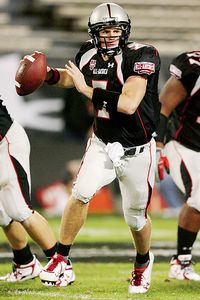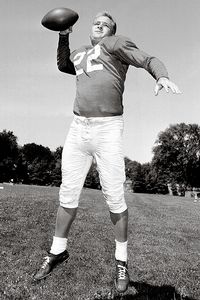Posted: Mon, 20 Jul 2009 11:09 AM - 11,603 Readers
By: Jim Miller
The vast fields that span the width and breadth of Texas produce a number of hearty crops, such as cotton, corn and soybeans.

And now quarterbacks, thanks greatly to the growth of high school spread offenses across the state since the early 1990s.
Chad Morris currently runs one of the best at Lake Travis (Austin). Last year's senior quarterback, Garrett Gilbert, was the national player of the year and broke his own state record by throwing for 4,854 yards for a state career-record 12,537.
Morris is no farmer, but he appears to make an apt analogy between the spread offense and a crop that thrives thanks to proper planning and care.
"You've got to have a program set in place that develops quarterbacks from the sixth grade up," said Morris, who arrived at Lake Travis a year ago after running a successful spread at Class 4A Stephenville. "It's not a one-year offense because you've got a certain kid."
While Gilbert has been Texas' best in terms of passing yards, he wasn't the first mega-passer at Lake Travis. His predecessor, Todd Reesing, piled up yards before heading off to Kansas to help the Jayhawks to their first BCS game.

Just over the state line east of Kansas, Chase Daniel performed similar magic at Missouri. Daniel came from another Texas spread-offense power, Carroll (Southlake). Carroll's ascent in state football ranks came almost as fast as the Dragons would reach the end zone. They were Class 3A champs in 1988, '92 and '93. After a brief stopover in 4A, they jumped to 5A in 2002 and claimed a state title that first season under coach Todd Dodge.
During the five-year span that ended with Dodge's departure for the University of North Texas after the '06 season, Carroll went undefeated in regular-season play, won four 5A championships and lost the other one by one point in the final to Katy. That would be an overall record of 79-1.
Hal Wasson took over from Dodge and has kept an offense that, as Morris described at Lake Travis, is a staple of the entire school district.
"It starts in our youth football league," Wasson said. "And I think what's misleading a lot -- people don't realize how important the running game is. When we're effective running, we're a lot more effective throwing downfield."
In Texas, Rusty Russell is considered the father of the high school spread offense. A graduate of Howard Payne University in the West Texas town of Brownwood, Russell arrived in 1927 at Fort Worth's Masonic Home, a boarding school for orphaned boys. The school was small, and the players were smaller; they were called the Mighty Mites for a reason.
To coach competitive football with these boys, Russell couldn't simply send his charges barreling into the line. The Mites had to go up or around, using a form of today's spread offense as the vehicle.
In Russell's 16 seasons at Masonic Home, the Mighty Mites qualified for the one-classification state playoffs 10 times. In 1932, they reached the championship game and battled Corsicana to a scoreless tie. (Corsicana was awarded the title on a statistical tiebreaker.)

Russell was lured over to the upscale Dallas community of Highland Park in 1942 -- sort of. He actually coached both Masonic Home and Highland Park for one season before making the break totally; he alternated practice days between the schools and scheduled their games on different dates.
Russell spent two more full seasons with the Highland Park Scots and coached a couple of the most memorable players in Texas football. His quarterback was Bobby Layne, who went on to star at Texas and in the NFL. The top running back was Doak Walker, whose popularity at nearby SMU led to the expansion of the Cotton Bowl stadium. Russell's 1944 Scots reached the state championship game before losing to Port Arthur (Texas) 20-7.
Most of Texas football remained conservative for the next 40 years, closely tethered to the running game. Remember that Darrell Royal, who won three national college championships (1963, '69, '70) with the Texas Longhorns, said that three things happen when you pass, and two of those are bad. About midway through Royal's long reign in Austin, Longhorns offensive coordinator Emory Bellard devised the triple-option wishbone, which led to similar formations like the veer-T.
Wingin' and flingin' were for schools that didn't have the muscle to move the ball downfield by land. John Jenkins' Run-and-Shoot Houston Cougars of the late 1980s and early '90s produced star quarterbacks like Heisman Trophy winner Andre Ware and David Klingler. They scored almost 100 points on one of SMU's first teams back from the "death penalty." But their equipment was long since stored away for the winter when teams were playing for the national championship.
Port Arthur is where Dodge played his high school ball. As a senior at Jefferson in 1980, he became the first state quarterback to throw for more than 3,000 yards. Jefferson reached the 5A final before losing to Permian (Odessa).
Dodge played at Texas under Royal's successor, Fred Akers, then went into coaching. He dabbled with aspects of the spread and the no-huddle as an assistant at Rockwall, helping the Yellowjackets reach the 4A final in 1987.

Two other spread devotees are Randy Allen and Sam Harrell, who worked together years ago in Brownwood. Allen used it at Cooper (Abilene) in the mid-1990s and brought it back to Highland Park in 1999. The Scots are annually in the hunt for the 4A title, winning in 2005 with a 59-0 blanking of Marshall.
While Allen settled in at Highland Park in '99, Harrell implemented the spread at Ennis and won 4A titles in 2000-01. Son Graham Harrell owned the state marks for yardage in a season and a career, then joined the aerial show at Texas Tech.
Before Morris coached at Stephenville, the spread was installed there by Art Briles. His teams claimed four 4A titles during the '90s before he moved into the college ranks, first as an offensive assistant at Tech under Mike Leach and then as a head coach at Houston and now Baylor.
With programs like Tech, Missouri and Kansas using spread offenses to improve their status in the Big 12 and high school teams like Carroll, Lake Travis, Highland Park, Stephenville and Ennis carting home championship trophies in late December, more state high school coaches have moved to the spread.
It does come with a gentle warning from Carroll's Wasson.
"I don't think you should do anything that you're not firmly committed to," Wasson said. "You've got to believe in it and know what you're doing. When we say committing to it, you've got to go out and throw and catch every day.
"There are two things pretty simple: If you can't protect and you can't route release, you're in the wrong offense."